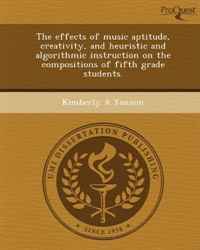The purpose of this research was to discern a relationship between instructional style and creativity as affected by creativity aptitude and music aptitude. The researcher defined instructional style as either algorithmic or heuristic. For instruction that is algorithmic, the teacher presents a step-by step problem-solving process. For instruction that is heuristic, the teacher presents more open-ended or problem-finding tasks. The author hypothesized that either an algorithmic or a heuristic approach may be more beneficial to a student depending on that student"s creativity aptitude and music aptitude. The present study involved 75 fifth grade children in intact classrooms in a suburban, middle class school system. The author administered Webster"s (1987) Measures of Creative Thinking in Music (MCTM) and Gordon"s (1995) Musical Aptitude Profile Rhythm I/II and Tonal I/II subtests (MAP) as independent measures. The participants began an eight-week instructional treatment period in which two intact class groups were taught composition using algorithmic, step-by-step procedures while the other two intact class groups were taught composition using heuristic, open-ended tasks. Both groups studied music and poetry that demonstrated the concepts of unity and variety. Following the eight-week treatment period, all participants composed a 30-second composition that employed evidence of unity and variety. Five independent judges scored the final compositions for overall creativity, technical goodness and aesthetic appeal using Amabile"s (1999) Consensual Assessment Technique (CAT). Data from MCTM (extensiveness, flexibility, originality, and syntax scores), MAP tonal and rhythm subtests, and CAT product creativity and technical goodness scores were analyzed using two-factor ANOVA. In addition, the author investigated the relationship between MCTM and product creativity. Although there were observable trends, the researcher found no main or interaction effects for creativity or technical goodness scores (CAT) and either instructional style or creativity aptitude (MCTM). In addition, the analysis yielded no significant relationship between MCTM and CAT. However, the analysis did reveal a significant effect of tonal aptitude (MAP) on product creativity scores (CAT). Это и многое другое вы найдете в книге The effects of music aptitude, creativity, and heuristic and algorithmic instruction on the compositions of fifth grade students (Kimberly A Yannon)
The effects of music aptitude, creativity, and heuristic and algorithmic instruction on the compositions of fifth grade students Kimberly A Yannon
Подробная информация о книге «The effects of music aptitude, creativity, and heuristic and algorithmic instruction on the compositions of fifth grade students Kimberly A Yannon»
